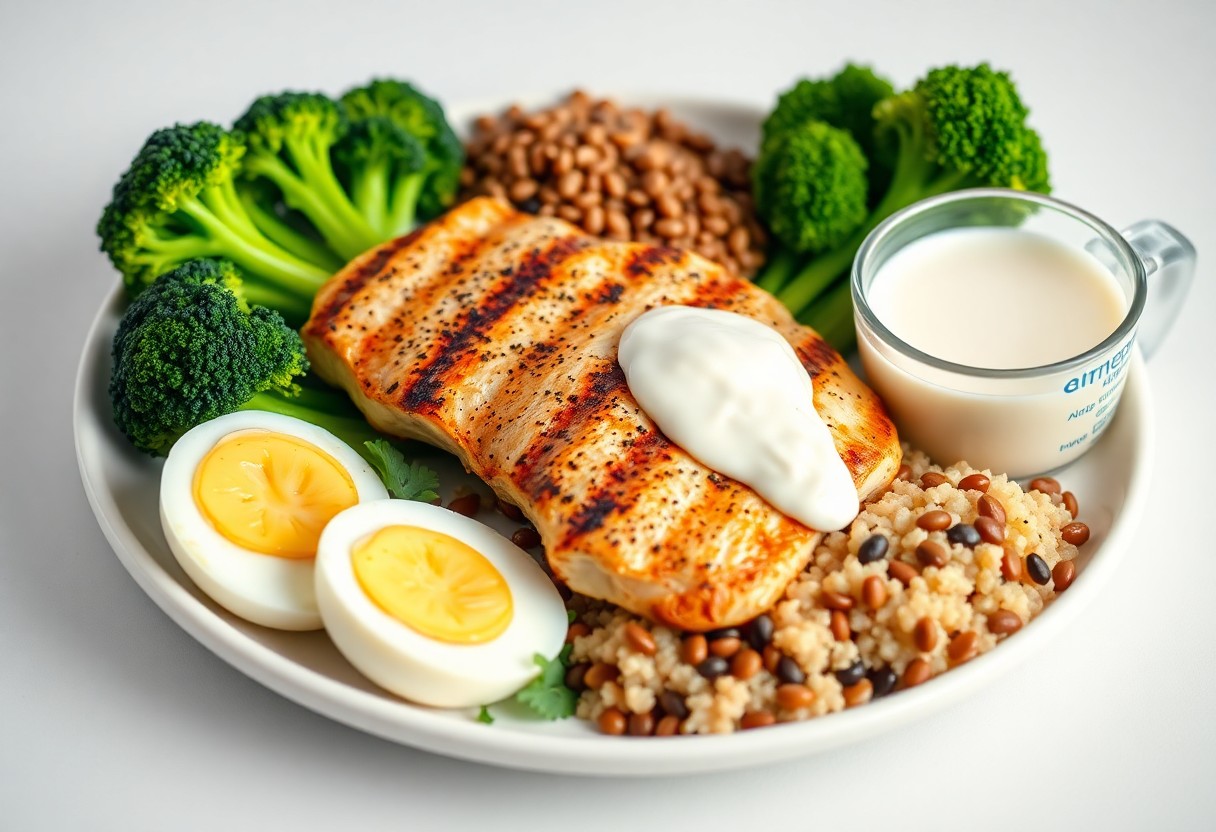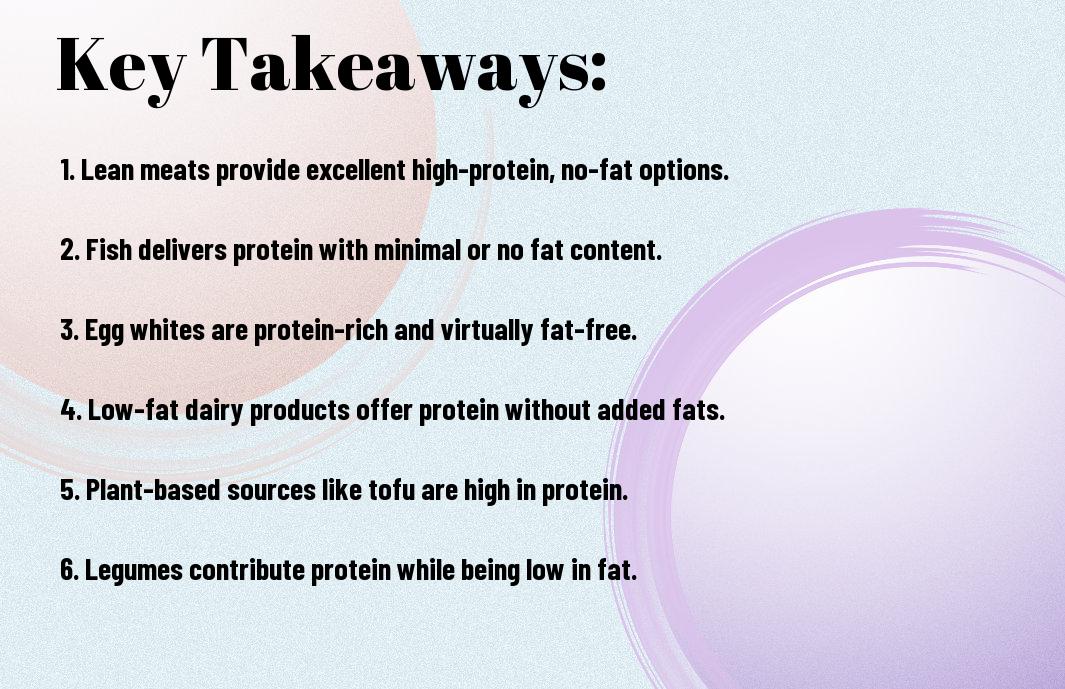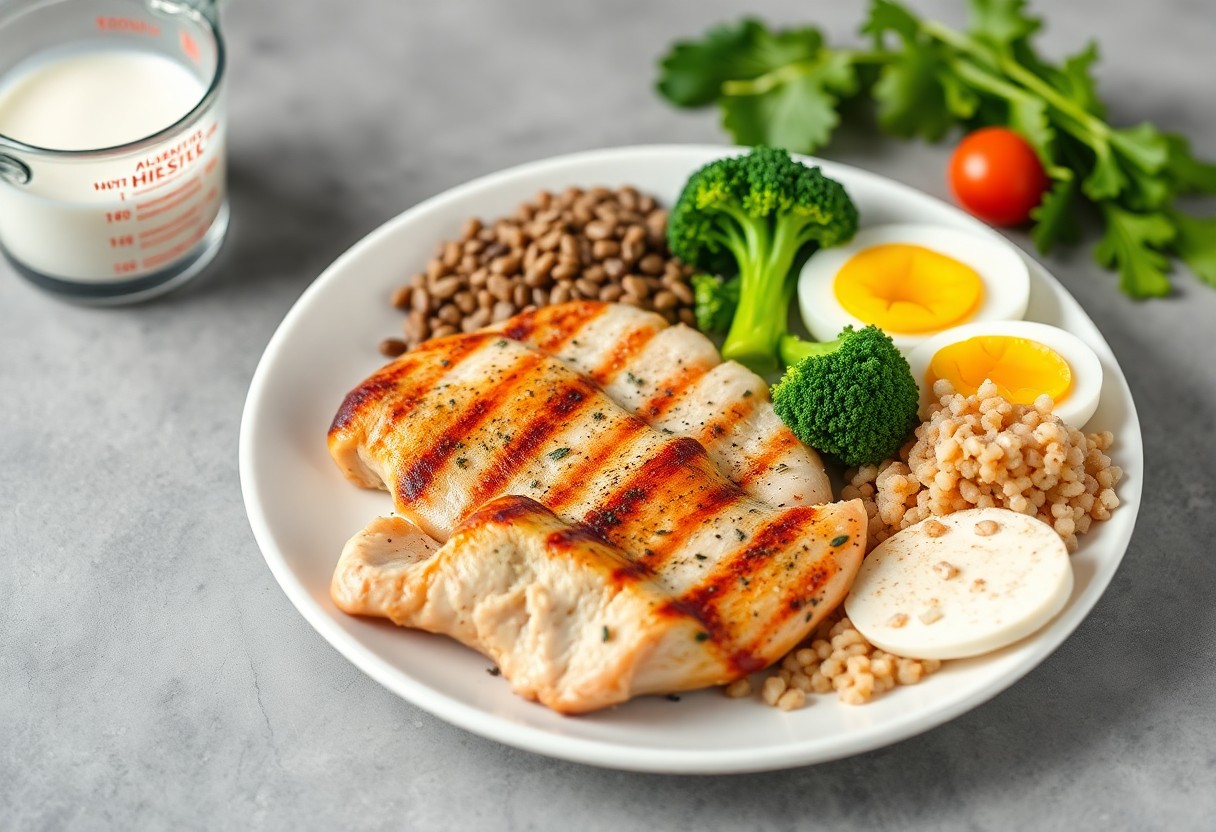Many individuals looking to enhance their fitness journey or weight loss efforts seek high-protein, no-fat foods that can fuel their bodies without adding unnecessary calories. This blog post will guide you through the best options available, showcasing choices that not only support muscle growth and recovery but also keep your diet in check. You’ll discover how incorporating these foods into your meals can provide the nutritional benefits you need while maintaining a healthy lifestyle. Let’s examine the top picks for your diet!

Key Takeaways:
- High-protein, no-fat foods can be excellent for muscle maintenance and repair, making them a great option for fitness enthusiasts and those aiming to lose weight.
- Foods such as lean fish, tofu, and certain legumes provide high protein without added fats, promoting a healthy dietary balance.
- Incorporating a variety of high-protein, no-fat foods into your diet can enhance satiety, support energy levels, and contribute to overall health.
Understanding High-Protein Foods
Before stepping into the specific benefits of high-protein, no-fat foods, it’s necessary to understand what high-protein foods actually are. These foods are rich in protein content, which is vital for muscle repair, growth, and overall bodily functions. Incorporating high-protein items into your diet can help you feel fuller longer and stabilize your energy levels throughout the day.
Definition and Benefits
HighProtein foods offer an abundance of digestive benefits, including improved muscle recovery, enhanced metabolic rate, and increased satiety. By selecting high-protein options, you can help manage weight more effectively, support your immune system, and improve your overall health. These foods are instrumental in building lean muscle and promoting fat loss while sustaining energy levels.
Importance of No-Fat Options
Definition: Opting for no-fat foods can be beneficial for various reasons, particularly for those looking to maintain or lose weight. Eliminating fat helps you lower overall calorie intake without sacrificing protein quality, allowing you to indulge in nutrient-dense foods.
Indeed, choosing no-fat options plays a vital role in managing your caloric intake while ensuring that you still receive an ample supply of necessary nutrients. These foods allow you to prioritize protein intake without the added calories that fats can bring, resulting in a healthier diet. Moreover, eliminating fat from your protein sources helps mitigate potential health risks, such as obesity and heart disease, making your dietary choices more beneficial for long-term wellness.

Top High-Protein, No-Fat Foods
The world of high-protein, no-fat foods is both diverse and delicious, allowing you to enrich your diet while keeping fat content at bay. Some of the best options come from legumes, lean meats, and seafood, each providing ample protein to support muscle growth and overall health. Incorporating these foods into your meals ensures you meet your nutritional needs without unnecessary fat, helping you maintain a balanced diet.
Legumes and Pulses
About the excellent high-protein, no-fat options, legumes and pulses are at the forefront. Foods such as lentils, chickpeas, and black beans not only offer significant protein but also pack in fiber, vitamins, and minerals. Including these in your diet will support your digestive health while providing a satisfying protein source that keeps you feeling full longer.
Lean Meats and Poultry
Poultry is another fantastic option when considering high-protein, no-fat foods. Chicken and turkey breast are particularly renowned for being lean sources of protein, ideal for building and repairing muscles. These meats provide the important amino acids your body needs without the added fats often found in other cuts.
Also, lean meats and poultry can be incredibly versatile, fitting into a variety of meals, from salads to stir-fries. Including them in your diet helps you achieve high protein intake while maintaining a low-fat profile. Opt for skinless selections to further reduce fat content, and always be mindful of cooking methods – grilling, boiling, or baking are excellent choices. With these proteins in your meal plan, you’ll enhance your nutritional profile and support your fitness goals effectively.
Dairy Alternatives
Now, if you’re looking to increase your protein intake while keeping fat to a minimum, dairy alternatives can be fantastic options. These products can provide satisfying flavors and textures without compromising your dietary goals. From soy to almond milk, there’s a wide variety to choose from as you navigate your high-protein, no-fat journey.
Low-Fat Yogurt and Cheese
Between the range of yogurt and cheese options, low-fat varieties stand out as excellent choices for packing protein without the extra fat. Low-fat yogurt not only supplies your body with crucial probiotics but also supports muscle recovery. Pair it with fruits or nuts for a nutrient-dense snack that’s both tasty and satisfying.
Plant-Based High-Protein Products
Against the trend of high-fat dairy, many plant-based products offer impressive protein content without fat. These options include tofu, tempeh, edamame, and lentils, which are perfect for meat alternatives in your meals. They not only help to keep your diet balanced but also contribute to sustainable eating practices.
It’s crucial to incorporate plant-based high-protein products into your diet, as they’re not only rich in protein but also low in fat. For instance, tofu and tempeh can serve as versatile bases for numerous recipes, absorbing flavors beautifully while providing a hearty protein punch. Additionally, options like edamame and lentils are excellent snacks that boost your energy levels without unhealthy fats. Switching to these alternatives can enhance your meals significantly, making it easier to meet your dietary goals while maintaining a healthy lifestyle.
Whole Grains and Their Roles
Unlike refined grains, whole grains retain their nutrient-rich bran and germ, providing you with valuable fiber, vitamins, and minerals crucial for a balanced diet. Incorporating whole grains into your meals can help maintain stable blood sugar levels and promote digestive health. They are versatile and can be easily mixed into both savory and sweet recipes, making them an excellent addition to your daily eating habits.
Quinoa and Farro
Along with being delicious, quinoa and farro are standout examples of high-protein, no-fat whole grains. Quinoa is a complete protein, meaning it supplies all crucial amino acids your body needs, while farro offers a hearty texture and nutty flavor. Both grains can serve as foundations for various dishes, from salads to grain bowls, ensuring you receive maximum nutrition without compromising on taste.
Other Whole Grain Options
With a variety of whole grains available, you can explore options like barley, bulgur, and brown rice, each boasting unique flavors and textures. These grains are often rich in fiber, which can help you feel fuller longer and curb appetite. Additionally, they provide an excellent source of micronutrients crucial for energy metabolism. Experimenting with different whole grains can enhance the diversity of your meals while supporting healthy digestive function and overall wellness.
Consequently, by including various whole grains in your diet, you can reap significant health benefits such as improved heart health and better digestion. Beyond just quinoa and farro, grains like millet and oats are excellent choices that not only add flavor but also increase your protein intake without any added fat. Exploring these options ensures you’re nourishing your body while keeping your meals exciting and satisfying. Prioritizing whole grains in your diet will also contribute to lasting energy levels and overall vitality.

High-Protein Snacks
For quick energy and muscle-building fuel, high-protein snacks are a great addition to your diet. They can help you stay satiated between meals and support your fitness goals without adding unnecessary fat. Look for options like Greek yogurt, hard-boiled eggs, and low-fat cottage cheese to keep your protein levels high and your fat levels low.
Seeds and Nuts
For a power-packed snack, consider integrating seeds and nuts into your diet. Foods like pumpkin seeds, chia seeds, and almonds not only deliver high levels of protein, but they also provide crucial nutrients and antioxidants. Choose raw or dry-roasted options to keep them low in fat while enjoying the satisfying crunch and flavor.
Protein Bars and Shakes
Behind every busy schedule, protein bars and shakes can serve as your perfect accomplices. These convenient snacks often pack a hefty protein punch while being low in fat, making them ideal for those on the go. However, be cautious of added sugars and fillers in some products that can negate their health benefits. Always check labels to ensure you choose a bar or shake that fits your dietary goals.
With so many options available, your protein needs can easily be met with protein bars and shakes. Look for those with at least 20 grams of protein and minimal sugars to maximize your nutritional intake. They can be a fantastic post-workout option or a meal replacement during busy days. Just be mindful of how they fit into your overall dietary plan, as some can be high in calories or contain artificial ingredients.
Incorporating High-Protein, No-Fat Foods into Your Diet
Not only can high-protein, no-fat foods enhance your meals, but they also provide vital nutrients without the extra calories. To incorporate these foods into your daily routine, consider replacing traditional staples with high-protein alternatives, such as introducing legumes, soy products, and low-fat dairy. By gradually integrating these options into your diet, you can improve your nutrition and support your fitness goals without sacrificing taste.
Meal Planning and Preparation
Among the many strategies for utilizing high-protein, no-fat foods, effective meal planning plays an vital role. Design your weekly meals around these protein-rich options, ensuring variety while maintaining focus on low-fat ingredients. Prepare larger batches and store them in portions, making healthy eating achievable throughout the week.
Creative Recipes and Pairings
Any time you think about meals, consider how you can creatively combine high-protein, no-fat foods with flavors and textures you love. For instance, combine chickpeas with fresh herbs and spices for a delicious salad or mix low-fat cottage cheese with fruits for a refreshing snack. These combinations not only enhance flavor but also keep meals exciting.
Planning out creative recipes and pairings can transform your dining experience and keep your taste buds engaged. Utilize ingredients like quinoa, lentils, and tofu as the base for meals, and enhance them with fresh vegetables and flavorful herbs. Together, these choices can create delicious, satisfying dishes that adhere to a high-protein, no-fat diet. Explore diverse cuisines to discover new ways to enjoy these nutritious foods while maintaining variety in your diet.
Conclusion
On the whole, incorporating high-protein, no-fat foods into your diet can enhance your nutritional intake while supporting your fitness goals. Options like lean meats, legumes, and certain dairy products provide you with crucial proteins without added fats, contributing to a balanced diet. By choosing these foods, you can effectively manage your weight, boost muscle growth, and maintain energy levels. Embrace these choices to optimize your health and well-being, ensuring that each meal contributes positively to your dietary objectives.
FAQ
Q: What are high-protein no-fat foods?
A: High-protein no-fat foods are items that provide a significant amount of protein without containing any fat. These foods can be beneficial for those looking to increase their protein intake while reducing fat consumption. Common examples include egg whites, certain fish like cod or sole, non-fat Greek yogurt, and various legumes when prepared in a low-fat manner.
Q: Why should I incorporate high-protein no-fat foods into my diet?
A: Incorporating high-protein no-fat foods can help support muscle growth, improve satiety, and assist in weight management. For individuals looking to lose weight or maintain a lean physique, these foods provide the necessary protein without the added calories from fat, allowing for a higher volume of food intake without excessive calorie consumption.
Q: Are there any drawbacks to eating a diet high in protein and low in fat?
A: While high-protein, no-fat foods can be beneficial, relying solely on them may lead to an unbalanced diet. It’s important to include healthy fats in moderation, as they are imperative for various bodily functions including nutrient absorption and hormone production. Additionally, some individuals may experience digestive discomfort if they consume an excessive amount of protein without adequate fiber from other food groups.
Q: Can I achieve my fitness goals with high-protein no-fat foods alone?
A: While high-protein no-fat foods can play a significant role in achieving fitness goals, they should be part of a well-rounded diet that includes carbohydrates, healthy fats, and a variety of fruits and vegetables. A balanced diet helps ensure that your body receives all the nutrients it needs to function optimally and support recovery during and after exercise.
Q: What are some easy ways to incorporate high-protein no-fat foods into my meals?
A: There are numerous ways to include high-protein no-fat foods in your meals. For breakfast, consider starting your day with non-fat Greek yogurt topped with fresh fruit. For lunch, prepare a salad with mixed greens, grilled chicken breast, and a squeeze of lemon for flavor. Dinner can feature steamed white fish paired with asparagus or zucchini noodles. Snacks can include edamame or a protein shake made with water and protein powder. Experimenting with different recipes can help keep your meals exciting and nutritious.
